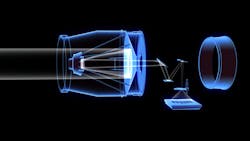NASA’s Roman Space Telescope team is currently busy integrating and testing the spacecraft’s electrical harness, or nervous system, which enables different parts of the observatory to communicate with each other.
Some serious assembly is required (see video). The harness weighs about 1000 pounds and is made of approximately 32,000 wires and 900 connectors (see Fig. 1, above). If its wires were laid out end to end, NASA says they’d span 45 miles.
The harness is a crucial piece of the spacecraft because it provides power and helps the central computer monitor the observatory’s function via an array of sensors.
It was built on an observatory mock-up structure before being transported to Goddard’s Space Environment Simulator—a massive thermal vacuum chamber used for “bakeout” to release harmful gases here on Earth rather than in space, where they can condense within electronics and cause problems like short circuits or leave deposits on sensitive optics in space.
Next up, engineers will weave the harness through the flight structure in Goddard’s cleanroom, where this process will continue until most of the spacecraft components are assembled.
Exploring big questions
The Roman Space Telescope is designed to explore essential questions about dark energy, exoplanets, and infrared astrophysics. It features two key instruments: a Wide Field Instrument (WFI) and a Coronagraph Instrument.
Its WFI is a 300 Mpixel infrared camera that will measure light from a billion galaxies during its 5-year mission lifetime (see Fig. 2). It’s designed so each Roman image will capture a patch of the sky bigger than the apparent size of a full Moon. It’ll also perform a microlensing survey of the inner Milky Way—monitoring 100 million stars to detect exoplanets.
The Coronagraph Instrument will perform high-contrast imaging and spectroscopy of nearby exoplanets—directly imaging exoplanets by blocking out a star’s light to allow fainter planets to be observed.

